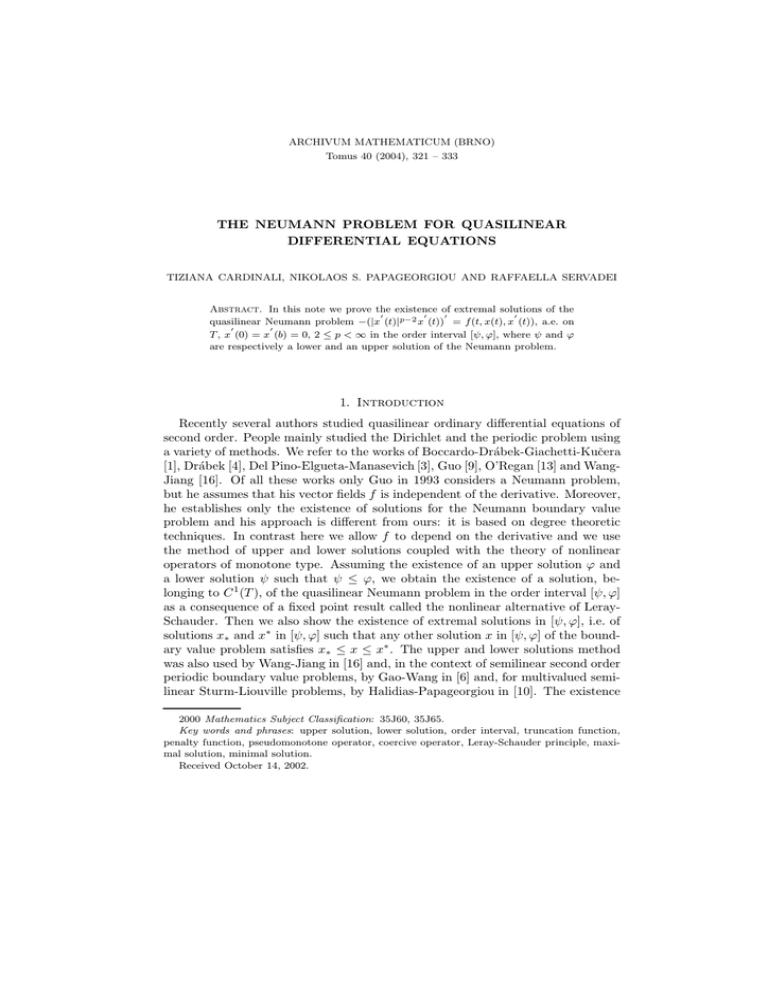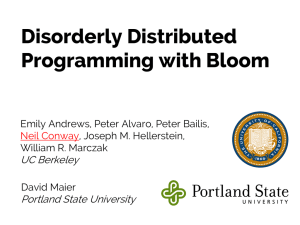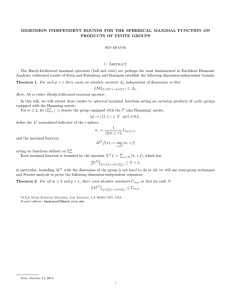THE NEUMANN PROBLEM FOR QUASILINEAR DIFFERENTIAL EQUATIONS
advertisement

ARCHIVUM MATHEMATICUM (BRNO)
Tomus 40 (2004), 321 – 333
THE NEUMANN PROBLEM FOR QUASILINEAR
DIFFERENTIAL EQUATIONS
TIZIANA CARDINALI, NIKOLAOS S. PAPAGEORGIOU AND RAFFAELLA SERVADEI
Abstract. In this note we prove the existence of extremal solutions of the
0
0
0
0
quasilinear Neumann problem −(|x (t)|p−2 x (t)) = f (t, x(t), x (t)), a.e. on
0
0
T , x (0) = x (b) = 0, 2 ≤ p < ∞ in the order interval [ψ, ϕ], where ψ and ϕ
are respectively a lower and an upper solution of the Neumann problem.
1. Introduction
Recently several authors studied quasilinear ordinary differential equations of
second order. People mainly studied the Dirichlet and the periodic problem using
a variety of methods. We refer to the works of Boccardo-Drábek-Giachetti-Kučera
[1], Drábek [4], Del Pino-Elgueta-Manasevich [3], Guo [9], O’Regan [13] and WangJiang [16]. Of all these works only Guo in 1993 considers a Neumann problem,
but he assumes that his vector fields f is independent of the derivative. Moreover,
he establishes only the existence of solutions for the Neumann boundary value
problem and his approach is different from ours: it is based on degree theoretic
techniques. In contrast here we allow f to depend on the derivative and we use
the method of upper and lower solutions coupled with the theory of nonlinear
operators of monotone type. Assuming the existence of an upper solution ϕ and
a lower solution ψ such that ψ ≤ ϕ, we obtain the existence of a solution, belonging to C 1 (T ), of the quasilinear Neumann problem in the order interval [ψ, ϕ]
as a consequence of a fixed point result called the nonlinear alternative of LeraySchauder. Then we also show the existence of extremal solutions in [ψ, ϕ], i.e. of
solutions x∗ and x∗ in [ψ, ϕ] such that any other solution x in [ψ, ϕ] of the boundary value problem satisfies x∗ ≤ x ≤ x∗ . The upper and lower solutions method
was also used by Wang-Jiang in [16] and, in the context of semilinear second order
periodic boundary value problems, by Gao-Wang in [6] and, for multivalued semilinear Sturm-Liouville problems, by Halidias-Papageorgiou in [10]. The existence
2000 Mathematics Subject Classification: 35J60, 35J65.
Key words and phrases: upper solution, lower solution, order interval, truncation function,
penalty function, pseudomonotone operator, coercive operator, Leray-Schauder principle, maximal solution, minimal solution.
Received October 14, 2002.
322
T. CARDINALI, N. S. PAPAGEORGIOU, R. SERVADEI
of extremal solutions in [ψ, ϕ] was addressed only by Halidias-Papageorgiou, using
different approach.
2. Preliminaries
0
If T = [0, b], let W 1,p (T ) = {x ∈ Lp (T ) | x ∈ Lp (T )} be the function space
1
0
equipped with the norm kxk = (kxkpp + kx kpp ) p : the space W 1,p (T ) is a separable,
reflexive Banach space for all 1 < p < ∞. It is well known that W 1,p (T ) embeds
continuously into C(T ), i.e. every element in W 1,p (T ) has a unique representative
into C(T ). Moreover W 1,p (T ) ,→ Lp (T ) compactly for all 1 ≤ p < ∞.
Let X a reflexive Banach space and X ∗ its topological dual. In what follows by
(., .) we denote the duality brackets of the pair (X, X ∗ ). A map A : X → X ∗ is said
to be ‘monotone’, if for all x1 , x2 ∈ X, we have (A(x2 ) − A(x1 ), x2 − x1 ) ≥ 0. A(·)
is said to be ‘strictly monotone’ if it is monotone and (A(x2 ) − A(x1 ), x2 − x1 ) = 0
implies x2 = x1 . We say that A(·) is maximal monotone, if its graph is maximal
monotone with respect to inclusion among the graphs of all monotone maps from X
into X ∗ . It follows from this definition that A(·) is maximal monotone if and only
if A is monotone and (v ∗ − A(x), v − x) ≥ 0 for all x ∈ X, implies v ∗ = A(v). An
operator A : X → X ∗ is said to be ‘demicontinuous’ at x ∈ X, if for every {xn }n∈N
w∗
with xn → x in X, we have A(xn ) → A(x) in X ∗ . A monotone demicontinuous
everywhere defined operator is maximal monotone (see Hu-Papageorgiou [11]). A
map A : X → X ∗ is said to be ‘pseudomonotone’, if for all x ∈ X and for every
w
sequence {xn }n∈N ⊆ X such that xn → x in X and lim sup(A(xn ), xn − x) ≤ 0, we
have that (A(x), x − y) ≤ lim inf(A(xn ), xn − y) for all y ∈ X. A map A : X → X ∗
→ ∞ as kxk → ∞. A pseudomonotone map
is said to be ‘coercive’ if (A(x),x)
kxk
which is also coercive is surjective. A single valued operator A : X → X ∗ is said
to be ‘compact’ if it is continuous and maps bounded sets into relatively compact
sets.
3. Existence result
Let T = [0, b] ⊂ R. The problem under consideration is the following:
(1)
0
0
0
0
−(|x (t)|p−2 x (t)) = f (t, x(t), x (t))
0
0
x (0) = x (b) = 0
a.e. on T
2≤p<∞
Let us start by introducing the hypotheses on the right hand side function
f (t, x, y).
H(f ): f : T × R × R → R is a function such that
(i) for all (x, y) ∈ R × R, t 7→ f (t, x, y) is measurable;
(ii) for almost all t ∈ T , (x, y) 7→ f (t, x, y) is continuous;
(iii) for almost all t ∈ T , all x ∈ [ψ(t), ϕ(t)] and all y ∈ R, we have
|f (t, x, y)| ≤ a(t) + c|y|p−1
with a ∈ Lq (T ), c > 0 and
1
p
+
1
q
= 1.
THE NEUMANN PROBLEM FOR QUASILINEAR DIFFERENTIAL EQUATIONS
323
Definition 1. By a solution of (1) we mean a function x ∈ C 1 (T ) such that
0
0
|x (·)|p−2 x (·) ∈ W 1,q (T ) and it satisfies (1).
As we already mentioned we shall employ the method of upper and lower solutions. So let us introduce these two concepts:
Definition 2. By an ’upper solution’ of (1) we mean a function ϕ ∈ C 1 (T ) such
0
0
that |ϕ (·)|p−2 ϕ (·) ∈ W 1,q (T ) and it satisfies
0
0
0
0
−(|ϕ (t)|p−2 ϕ (t)) ≥ f (t, ϕ(t), ϕ (t)) a.e. on T
(2)
0
0
ϕ (0) ≤ 0 ≤ ϕ (b)
Definition 3. By a ’lower solution’ of (1) we mean a function ψ ∈ C 1 (T ) such
0
0
that |ψ (·)|p−2 ψ (·) ∈ W 1,q (T ) and it satisfies
0
0
0
0
−(|ψ (t)|p−2 ψ (t)) ≤ f (t, ψ(t), ψ (t)) a.e. on T
(3)
0
0
ψ (b) ≤ 0 ≤ ψ (0)
We will assume the existence of an upper solution ϕ and a lower solution ψ.
More precisely we make the following hypothesis:
H0 : There exist an upper solution ϕ and a lower solution ψ of problem (1) such
that ψ(t) ≤ ϕ(t) for all t ∈ T .
We introduce the operator A : W 1,p (T ) → W 1,p (T )∗ defined by
Z b
0
0
0
hA(x), yi =
|x (t)|p−2 x (t)y (t) dt
0
for all y ∈ W
1,p
(T ).
Proposition 1. A : W 1,p (T ) → W 1,p (T )∗ is maximal monotone.
Proof. It suffices to show that A is monotone, demicontinuous.
First we show the monotonicity of A. For all x, y ∈ W 1,p (T ) we have
hA(x) − A(y), x − yi =
Rb
0 (|x
0
0
0
0
0
0
(t)|p−2 x (t) − |y (t)|p−2 y (t))(x (t) − y (t)) dt ≥ 0
from the well-known inequality (see Hu-Papageorgiou [11], p. 303).
Next we show the demicontinuity of A. To this end, let xn → x in W 1,p (T ) as
0
n → ∞. By passing to a subsequence if necessary, we may assume that xn (t) →
0
0
x (t) a.e. on T and there exists k ∈ Lp (T ) such that |xn (t)| ≤ k(t) a.e. on T for
0
0
0
0
all n ∈ N. Thus we deduce that |xn |p−2 xn → |x |p−2 x in Lq (T ) as n → ∞. So
for every y ∈ W 1,p (T ) we have
Z b
0
0
0
0
0
hA(xn ) − A(x), yi =
(|xn (t)|p−2 xn (t) − |x (t)|p−2 x (t))y (t) dt → 0
0
324
T. CARDINALI, N. S. PAPAGEORGIOU, R. SERVADEI
as n → ∞.
w
We conclude that A(xn ) → A(x) in W 1,p (T )∗ , i.e. A is demicontinuous.
Because A is monotone and demicontinuous, A is maximal monotone.
Let A1 : D1 ⊆ Lp (T ) → Lq (T ) be defined by A1 (x) = A(x) for all x ∈
D1 = {y ∈ W 1,p (T ) | A(y) ∈ Lq (T )}.
Proposition 2. A1 : D1 ⊆ Lp (T ) → Lq (T ) is maximal monotone.
Proof. Let J : Lp (T ) → Lq (T ) be defined by J(x)(·) = |x(·)|p−2 x(·). To establish
the result of the proposition, it suffices to show that R(A1 + J) = Lq (T ). Indeed,
let this surjectivity condition be true and let v ∈ D1 , v ∗ ∈ Lq (T ) be such that
(A1 (x) − v ∗ , x − v)pq ≥ 0
(4)
for all x ∈ D1 . Since we have assumed that R(A1 + J) = Lq (T ), we can find
x0 ∈ D1 such that
A1 (x0 ) + J(x0 ) = v ∗ + J(v)
Using this in (4) above, we obtain
(J(v) − J(x0 ), v − x0 )pq ≥ 0 .
But J(·) is strictly monotone. Hence it follows that x0 = v and so A1 (x0 ) = v ∗ .
This proves the maximality of A1 (·). To show the previous range condition, we
proceed as follows. Let Jˆ = i ◦ J|W 1,p (T ) where i is the embedding operator and
J|W 1,p (T ) is the restriction of J on W 1,p (T ). Then Jˆ : W 1,p (T ) → W 1,p (T )∗
is continuous, monotone, D(Jˆ) = W 1,p (T ), hence maximal monotone (see HuPapageorgiou [11], Corollary III.1.35, p. 309). So from this fact together with
Proposition 1 and Theorem III.3.3, p. 334 of Hu-Papageorgiou [11], we have that
A + Jˆ : W 1,p (T ) → W 1,p (T )∗ is maximal monotone. Moreover, we have
0
ˆ
hA(x) + J(x),
xi = hA(x), xi + (Jˆ(x), x)pq = kx kpp + kxkpp = kxkp1,p .
Thus A + Jˆ(·) is coercive. But a maximal monotone coercive operator is surjective
(see, for example, Corollary III.2.19, p. 332 of Hu-Papageorgiou [11]). Hence
ˆ = W 1,p (T )∗ . Therefore given g ∈ Lq (T ) we can find x ∈ W 1,p (T ) such
R(A + J)
ˆ
ˆ
that A(x) + J(x)
= g. So A(x) = g − J(x)
∈ Lq (T ) and then A(x) = A1 (x).
q
Hence A1 (x) + J(x) = g. Because g ∈ L (T ) was arbitrary, we conclude that
R(A1 + J) = Lq (T ).
In the next proposition we describe the range of A1 by means of a boundary
value problem.
Proposition 3. If g ∈ R(A1 ) then, for every x ∈ D1 such that A1 (x) = g, we
have
0
0
0
−(|x (t)|p−2 x (t)) = g(t) a.e. on T
(5)
0
0
x (0) = x (b) = 0
0
0
and x ∈ C 1 (T ) with |x (·)|p−2 x (·) ∈ W 1,q (T ).
THE NEUMANN PROBLEM FOR QUASILINEAR DIFFERENTIAL EQUATIONS
325
Proof. For every ϕ ∈ C0∞ ((0, b)) we have
(A1 (x), ϕ)pq = (g, ϕ)pq
that is
Z
(6)
b
0
|x (t)|
p−2
0
0
x (t)ϕ (t) dt =
0
Z
b
g(t)ϕ(t) dt
0
So from the definition of the distributional derivative we infer that
0
0 0
0
0
−(|x |p−2 x ) = g and |x |p−2 x ∈ W 1,q (T ) .
0
0
Recall that W 1,q (T ) is embedded continuously in C(T ). So |x (·)|p−2 x (·) ∈ C(T ).
Let h : R → R be defined by h(r) = |r|p−2 r. This is continuous, strictly monotone
and so h−1 : R → R is well-defined and it is easily seen to be continuous. Hence
0
0
0
h−1 (|x (·)|p−2 x (·)) = x (·) ∈ C(T ). Using Green’s formula (integration by parts),
1,p
for every y ∈ W (T ), we have
(7)
Z
b
g(t)y(t) dt = −
b
Z
0
0
0
(|x (t)|p−2 x (t)) y(t) dt
0
0
=
Z
b
0
0
0
0
0
0
0
|x (t)|p−2 x (t)y (t) dt − |x (b)|p−2 x (b)y(b) + |x (0)|p−2 x (0)y(0) .
0
So, by equality (6), we have
0
0
0
0
|x (b)|p−2 x (b)y(b) = |x (0)|p−2 x (0)y(0) .
(8)
Let y ∈ W 1,p (T ) be such that y(0) = y(b) = 1 (for example take y(t) = 1 for all
t ∈ T ). We have
0
0
0
0
0
0
|x (b)|p−2 x (b) = |x (0)|p−2 x (0) .
Hence
0
0
h−1 (|x (b)|p−2 x (b)) = h−1 (|x (0)|p−2 x (0))
0
0
and so x (b) = x (0). Using this in (8) and because y ∈ W 1,p (T ) is arbitrary, we
0
0
conclude that x (b) = x (0) = 0.
Our application of the upper and lower solutions method will proceed via
truncation and penalization techniques. So we introduce the truncation map
τ : W 1,p (T ) → W 1,p (T ) be defined by
ϕ(t) if ϕ(t) ≤ x(t)
τ (x)(t) = x(t) if ψ(t) ≤ x(t) ≤ ϕ(t)
ψ(t) if x(t) ≤ ψ(t) .
326
T. CARDINALI, N. S. PAPAGEORGIOU, R. SERVADEI
It is clear that τ (·) is continuous.
0
We observe that τ (x) ∈ Lp (T ) being
0
ϕ (t)
0
0
τ (x) (t) = x (t)
0
ψ (t)
if ϕ(t) ≤ x(t)
if ψ(t) ≤ x(t) ≤ ϕ(t)
if x(t) ≤ ψ(t) .
The penalty function u : T × R → R is defined by
p−1
if ϕ(t) ≤ x
(x − ϕ(t))
u(t, x) = 0
if ψ(t) ≤ x ≤ ϕ(t)
−(ψ(t) − x)p−1 if x ≤ ψ(t) .
It is clear that u(·, ·) is a Carathéodory function such that
|u(t, x)| ≤ a1 (t) + c1 |x|p−1
a.e. on T
and
Z
0
q
b
u(t, x(t))x(t) dt ≥ kxkpp − c2 kxkp−1
p
for all x ∈ Lp (T )
with a1 ∈ L (T ) and c1 , c2 > 0. Using τ (·) and u(·, ·), we introduce the following
auxiliary problem:
0
0
0
0
−(|x (t)|p−2 x (t)) = f (t, τ (x)(t), τ (x) (t)) − α u(t, x(t)) a.e. on T
(9)
0
0
x (0) = x (b) = 0
2≤p<∞
where α > 0. In what follows let K = [ψ, ϕ] = {x ∈ C 1 (T ) | ψ(t) ≤ x(t) ≤
ϕ(t) for all t ∈ T }.
Proposition 4. If hypotheses H0 and H(f ) hold, then problem (1) has a solution
x in K = [ψ, ϕ].
Proof. First we establish the existence of solutions for problem (9) and then we
show that every such solution belongs in K. Hence from the definition of the
truncation map τ (·) and the penalty function u(·, ·), we can conclude that these
are also solutions of problem (1). From the proof of Proposition 2 we know that
G = A1 + J : D1 ⊆ Lp (T ) → Lq (T ) is surjective and strictly monotone. So
G−1 : Lq (T ) → D1 is well defined.
Claim 1: G−1 is strongly continuous from Lq (T ) to W 1,p (T ) (see Zeidler [17],
p.597; remark that strong continuity implies compactness and strong continuity is
also referred to as complete continuity).
w
We need to show that if yn → y in Lq (T ), then G−1 (yn ) → G−1 (y) in W 1,p (T ).
−1
Let xn = G (yn ), n ∈ N and x = G−1 (y). We have
A1 (xn ) + J(xn ) = yn .
and so
(A1 (xn ), xn )pq + (J(xn ), xn )pq = (yn , xn )pq .
THE NEUMANN PROBLEM FOR QUASILINEAR DIFFERENTIAL EQUATIONS
327
By definition of A1 and J, we obtain
0
kxn kpp + kxn kpp ≤ M1 kxn kp
where kyn kq ≤ M1 for all n ∈ N. Then we conclude that
kxn k1,p ≤ M2
for some M2 > 0 and all n ∈ N. Thus, by passing to a subsequence if necessary, we
w
may assume xn → x̂ in W 1,p (T ) and xn → x̂ in Lp (T ) (since W 1,p (T ) is embedded
p
compactly in L (T )). So we have
(A1 (xn ) + J(xn ), xn − x̂)pq = (yn , xn − x̂)pq → 0
as n → ∞. Since J(xn ) → J(x̂) in Lq (T ), being J : Lp (T ) → Lq (T ) continuous,
we have
lim sup(A1 (xn ), xn − x̂)pq = lim suphA(xn ), xn − x̂i = 0 .
But from Proposition 1 we know that A(·) is maximal monotone and D(A) =
W 1,p (T ), hence A(·) is pseudomonotone. So we have
hA(xn ), xn i → hA(x̂), x̂i
and so
0
0
kxn kp → kx̂ kp .
0
w
0
Since we also have that xn → x̂ in Lp (T ) and the space Lp (T ) has the Kadec0
0
Klee property (being uniformly convex), we have that xn → x̂ in Lp (T ) and then
xn → x̂ in W 1,p (T ). So we have
w
A(xn ) + J(xn ) → A(x̂) + J(x̂) in W 1,p (T )∗
as n → ∞. Hence A(x̂)+J(x̂) = y and then A1 (x̂)+J(x̂) = y. Because (A1 +J)(·)
is strictly monotone, we infer that x̂ = x. Therefore we conclude that xn → x in
W 1,p (T ), which proves the claim.
Next let Hα : W 1,p (T ) → Lq (T ) be defined by
0
Hα (x)(·) = f (·, τ (x)(·), τ (x) (·)) − α u(·, x(·)) + J(x)(·) .
By virtue of hypotheses H(f ), the properties of τ (·) and u(·, ·), we infer that Hα
is bounded and continuous.
Now using Proposition 3, we see that the solvability of problem (9) is equivalent
to solving the fixed point problem
x = G−1 Hα (x) .
(10)
Since G−1 Hα is compact, to solve problem (10), we shall use the Leray-Schauder
principle. This require to show that the set
Ŝα = {x ∈ W 1,p (T ) | x = λG−1 Hα (x) for some 0 < λ < 1}
is bounded.
Claim 2: Ŝα ⊆ W 1,p (T ) is bounded for some α > 0.
328
T. CARDINALI, N. S. PAPAGEORGIOU, R. SERVADEI
If x ∈ Ŝα , we have
x
G( ) = Hα (x)
λ
for some λ ∈]0, 1[ and so
x
(G( ), x)pq = (Hα (x), x)pq .
λ
By definition of G and Hα , we obtain
Z b 0 p−2 0
Z b
x (t) 0
x (t) x(t) p−2 x(t)
x (t) dt +
x(t) dt
λ
λ
λ
λ
0
0
Z b
0
=
f (t, τ (x)(t), τ (x) (t))x(t) dt
0
−α
Z
b
u(t, x(t))x(t) dt +
0
Z
b
|x(t)|p−2 x(t)x(t) dt.
0
Using hypotheses H(f )(iii), the properties of τ (·) and u(·, ·) and Young’s inequality, we have
0
1
(kx kpp + kxkpp )
p−1
λ
0
≤ kakq kxkp + c̃kxkp + c̄kx kp−1
kxkp − αkxkpp + α c2 kxkpp−1 + kxkpp
p
c̄p
0
c̄
kx kpp +
− α + 1 kxkpp + α c2 kxkp−1
≤ (kakq + c̃)kxkp +
p
q
q
p
p
c̄
c̄
p−1
kxkpw +
− α + 1 kxkpp + α c2 kxkw
≤ (kakq + c̃)kxkw +
q
q
p
where c̃, c̄, c2 , > 0. So we obtain
1
c̄p
c̄ p−1
(11)
− q kxkpw ≤ (kakq + c̃)kxkw +
− α + 1 kxkpp + α c2 kxkw
p−1
λ
q
p
Now, choosing > 0 such that
1
λp−1
−
c̄
>0
qq
and α > 0 such that
c̄p
+1,
p
we can conclude, by using the inequality (11), that Ŝα is bounded in W 1,p (T ) and
this proves Claim 2.
α>
Claims 1 and 2 allow us to apply the Leray-Schauder principle and obtain
x ∈ D1 such that x = G−1 Hα (x). Then G(x) = Hα (x) and so A1 (x) = Ĥα (x) ∈
0
Lq (T ), where Ĥα (x)(·) = f (·, τ (x)(·), τ (x) (·))−α u(·, x(·)). So by virtue of Propop
sition 3, we have that x is a solution of the auxiliary problem (9), with α > c̄p +1,
1
where c̄ > 0 and > 0 are such that λp−1
− qc̄q > 0.
THE NEUMANN PROBLEM FOR QUASILINEAR DIFFERENTIAL EQUATIONS
329
Next we show that x ∈ K = [ψ, ϕ]. Fixed α as above, we have
A1 (x) = Ĥα (x) .
and so
(A1 (x), (ψ − x)+ )pq = (Ĥα (x), (ψ − x)+ )pq .
By definition of A1 and Ĥα , we obtain
Z b
0
0
0
(12)
|x (t)|p−2 x (t)((ψ − x)+ ) (t) dt
0
=
Z
b
0
f (t, τ (x)(t), τ (x) (t))(ψ − x)+ (t) dt − α
0
Z
b
u(t, x(t))(ψ − x)+ (t) dt .
0
Also since ψ(·) is a lower solution, by definition we have
Z b
Z b
0
0
p−2 0
+ 0
(13)
f (t, ψ(t), ψ (t))(ψ − x)+ (t) dt .
|ψ (t)| ψ (t)((ψ − x) ) (t) dt ≤
0
0
From (12) and (13), we obtain
Z
0
0
0
0
0
(|x (t)|p−2 x (t) − |ψ (t)|p−2 ψ (t))(ψ − x) (t)dt
{ψ≥x}
≥
(14)
Z
b
0
0
(f (t, τ (x)(t), τ (x) (t)) − f (t, ψ(t), ψ (t)))(ψ − x)+ (t) dt
0
−α
Z
b
u(t, x(t))(ψ − x)+ (t) dt .
0
Note that
Z
(15)
0
0
0
0
0
(|x (t)|p−2 x (t) − |ψ (t)|p−2 ψ (t))(ψ − x) (t)dt ≤ 0
{ψ≥x}
and
Z
(16)
b
0
0
0
(f (t, τ (x)(t), τ (x) (t)) − f (t, ψ(t), ψ (t)))(ψ − x)+ (t) dt
Z
0
0
=
(f (t, ψ(t), ψ (t)) − f (t, ψ(t), ψ (t)))(ψ − x)(t)dt = 0 .
{ψ≥x}
Using (15) and (16) in (14) we obtain
Z b
−α
u(t, x(t))(ψ − x)+ (t) dt ≤ 0 .
0
By definition of the penalty function, we have
Z b
(ψ − x)p−1 (t)(ψ − x)+ (t) dt ≤ 0
0
and so
k(ψ − x)+ kpp ≤ 0 .
Then since ψ − x ∈ C(T ), we have ψ(t) ≤ x(t) for all t ∈ T .
330
T. CARDINALI, N. S. PAPAGEORGIOU, R. SERVADEI
In a similar fashion we show that x ≤ ϕ. So x ∈ K = [ψ, ϕ]. Therefore x is a
solution of problem (1) in K.
Next we establish the existence of extremal solutions in the order interval K =
[ψ, ϕ]
Theorem 1. If hypotheses H0 and H(f ) hold then problem (1) has extremal solutions in K.
Proof. Let S be the set of solutions of problem (1) in the order interval K = [ψ, ϕ].
We show that (S, ≤) is directed, i.e. for all x1 , x2 ∈ S there exists x3 ∈ S such that
x1 ≤ x3 and x2 ≤ x3 . For this purpose, fixed x1 , x2 ∈ S, we consider the function
y = x 1 ∨ x2 .
For each > 0, let ξ ∈ Lip(R) be defined by
0 if t ≤ 0
ξ (t) = t if 0 < t <
1 if ≤ t .
Note that ξ → χ{t>0} as ↓ 0. Let θ ∈ C0∞ ((0, b)), θ ≥ 0 and set
θ1 = (1 − ξ (x2 − x1 ))θ
and θ2 = ξ (x2 − x1 )θ .
Evidently θ1 , θ2 ≥ 0 and, from the chain rule for Sobolev functions, we have
0
0
0
0
0
0
(θ1 ) = θ − ξ (x2 − x1 )(x2 − x1 ) θ − ξ (x2 − x1 )θ
0
and
0
0
(θ2 ) = ξ (x2 − x1 )(x2 − x1 ) θ + ξ (x2 − x1 )θ .
Since by hypothesis x1 , x2 ∈ S we have
(A1 (x1 ), θ1 )pq = (fˆ(x1 ), θ1 )pq
and
(A1 (x2 ), θ2 )pq = (fˆ(x2 ), θ2 )pq
0
ˆ
with f(y(·))
= f (·, y(·), y (·)) for all y ∈ W 1,p (T ). We have
(A1 (x1 ), θ1 )pq + (A1 (x2 ), θ2 )pq
Z b
0
0
0
0
0
0
=
(|x2 (t)|p−2 x2 (t) − |x1 (t)|p−2 x1 (t))ξ (x2 − x1 )(t)(x2 − x1 ) (t)θ(t) dt
0
+
Z
+
Z
b
0
b
0
0
0
0
0
0
0
0
(|x2 (t)|p−2 x2 (t) − |x1 (t)|p−2 x1 (t))ξ (x2 − x1 )(t)θ (t) dt
0
(|x1 (t)|p−2 x1 (t)θ (t) dt .
0
Note that ξ (x2 − x1 )θ ≥ 0 and
0
0
0
0
0
(|x2 (t)|p−2 x2 (t) − |x1 (t)|p−2 x1 (t))(x2 − x1 ) (t) ≥ 0 .
THE NEUMANN PROBLEM FOR QUASILINEAR DIFFERENTIAL EQUATIONS
331
Hence
(A1 (x1 ), θ1 )pq + (A1 (x2 ), θ2 )pq
Z b
0
0
0
0
0
≥
(|x2 (t)|p−2 x2 (t) − |x1 (t)|p−2 x1 (t))ξ (x2 − x1 )(t)θ (t) dt
0
+
Z
b
0
0
0
0
(|x1 (t)|p−2 x1 (t)θ (t) dt .
Passing to the limit as ↓ 0, we obtain
lim inf[(A1 (x1 ), θ1 )pq + (A1 (x2 ), θ2 )pq ]
Z b
0
0
0
≥
|x2 (t)|p−2 x2 (t)χ{x2 ≥x1 } (t)θ (t) dt
0
+
=
Z
Z
b
0
b
0
0
0
|x1 (t)|p−2 x1 (t)χ{x2 ≤x1 } (t)θ (t) dt
0
0
0
|y (t)|p−2 y (t)θ (t) dt = (A1 (y), θ)pq .
0
Also we have
ˆ 1 ), θ )pq + (fˆ(x2 ), θ )pq → (fˆ(y), θ)pq
(f(x
1
2
as ↓ 0. Thus finally in the limit as ↓ 0, we obtain
(A1 (y), θ)pq ≤ (fˆ(y), θ)pq ,
for all θ ∈ C0∞ ((0, b)), θ ≥ 0. Then
Z b
Z
0
0
0
|y (t)|p−2 y (t)θ (t) dt ≤
0
0
b
0
f (t, y(t), y (t))θ(t) dt
0
0
and so, by Green’s identity, since y (0) = y (b) = 0, we have
Z b
Z b
0
0
0
0
−(|y (t)|p−2 y (t)) θ(t) dt ≤
f (t, y(t), y (t))θ(t) dt .
0
0
Then, since θ ∈ C0∞ ((0, b)), θ ≥ 0 is arbitrary, we infer that the function y = x1 ∨x2
satisfies the following properties
0
0
0
0
−(|y (t)|p−2 y (t)) ≤ f (t, y(t), y (t)) a.e. on T
(17)
0
0
y (b) = 0 = y (0)
0
0
and y is a continuous function such that |y (·)|p−2 y (·) ∈ W 1,q (T ). Therefore
(we observe that in order to prove the existence of a function x3 is not necessary
y ∈ C 1 (T )), as in the proof of Proposition 4, we can find x3 ∈ S such that
y ≤ x3 ≤ ϕ. Hence (S, ≤) is directed.
Next let C be a chain of S. Let x = sup C. Using Corollary 7, p. 336 of
Dunford-Schwartz [5], we can find {xn }n∈N ⊆ C non decreasing such that xn → x
in Lp (T ). We have
ˆ n)
A(xn ) = f(x
332
T. CARDINALI, N. S. PAPAGEORGIOU, R. SERVADEI
and so
(A(xn ), xn )pq = (fˆ(xn ), xn )pq .
Using hypothesis H(f )(iii), we obtain
0
0
kxn kpp ≤ M (kakq + ckxn kp−1
)
p
where M > 0. Then {xn }n∈N ⊆ W 1,p (T ) is bounded. So we may assume that
w
xn → x in W 1,p (T ). Also we have
lim(A(xn ), xn )pq = lim(fˆ(xn ), xn )pq = 0
and so, being A pseudomonotone, we can say
0
0
kxn kp → kx kp .
Hence, by the Kadec-Klee property, xn → x in W 1,p (T ). So in the limit as n → ∞,
we have A(x) = fˆ(x) a.e. on T and so, by Proposition 3,
0
0
0
0
−(|x (t)|p−2 x (t)) = f (t, x(t), x (t)) a.e. on T
(18)
0
0
x (0) = x (b) = 0
i.e. x ∈ S.
Apply Zorn’s lemma to obtain a maximal element x∗ of (S, ≤). Since (S, ≤)
is directed, x∗ is unique and it is the maximal solution of problem (1) in K. On
the other hand, S is directed with respect to ≥, i.e. for all x1 , x2 ∈ S there exists
x3 ∈ S such that x1 ≥ x3 and x2 ≥ x3 (see Peressini [15], p.3). Similarly we
prove the existence of a maximal element x∗ of (S, ≥). Therefore x∗ is the unique
minimal solution of problem (1) in K.
References
[1] Boccardo, L., Drábek, P., Giachetti, D., Kučera, M., Generalization of Fredholm alternative
for nonlinear differential operators, Nonlinear Anal. 10 (1986), 1083–1103.
[2] Brézis, H., Analyse functionelle: Théorie et applications, Masson, Paris 1983.
[3] Del Pino, M., Elgueta, M., Manasevich, R., A homotopic deformation along p of a Leray0
0
0
Schauder degree result and existence for (|u (t)|p−2 u (t)) + f (t, u(t)) = 0, u(0) = u(T ) =
0, p > 1), J. Differential Equations 80 (1989), 1–13.
[4] Drábek, P., Solvability of boundary value problems with homogeneous ordinary differential
operator, Rend. Istit. Mat. Univ. Trieste 18 (1986), 105–125.
[5] Dunford, N., Schwartz, J. T., Linear operators. Part I: General theory, Interscience Publishers, New York 1958–1971.
[6] Gao, W., Wang, J., A nonlinear second order periodic boundary value problem with
Carathéodory functions, Ann. Polon. Math. LXVII. 3 (1995), 283–291.
[7] Gilbarg, D., Trudinger, N., Elliptic partial differential equations of second order, SpringerVerlag, Berlin 1983.
[8] Dugundji, J., Granas, A., Fixed point theory, Vol. I, Monogr. Mat. PWN, Warsaw 1992.
[9] Guo, Z., Boundary value problems of a class of quasilinear ordinary differential equations,
Differential Integral Equations 6, No. 3 (1993), 705–719.
[10] Halidias, N., Papageorgiou, N. S., Existence of solutions for nonlinear parabolic problems,
Arch. Math. (Brno) 35 (1999), 255–274.
THE NEUMANN PROBLEM FOR QUASILINEAR DIFFERENTIAL EQUATIONS
333
[11] Hu, S., Papageorgiou, N. S., Handbook of multivalued analysis. Volume I: Theory, Kluwer,
Dordrecht, The Netherlands 1997.
[12] Marcus, M., Mizel, V. J., Absolute continuity on tracks and mapping of Sobolev spaces,
Arch. Rational Mech. Anal. 45 (1972), 294–320.
0
0
[13] O’Regan, D., Some General existence principles and results for (φ(y )) = qf (t, y, y ), 0 <
t < 1∗ , SIAM J. Math. Anal. 24 No. 30 (1993), 648–668.
[14] Pascali, D., Sburlan, S., Nonlinear mapping of monotone type, Editura Academiei, Bucuresti, Romania 1978.
[15] Peressini, A. L., Ordered topological vector spaces, Harper & Row, New York, Evanstone,
London 1967.
[16] Wang, J., Jiang, D., A unified approach to some two-point, three-point and four-point boundary value problems with Carathéodory functions, J. Math. Anal. Appl. 211 (1997), 223–232.
[17] Zeidler, E., Nonlinear functional analysis and its applications II, Springer-Verlag, New York
1990.
University of Perugia, Department of Mathematics and Computer Science
via Vanvitelli 1, Perugia 06123, Italy
National Technical University, Department of Mathematics
Zografou Campus, Athens 15780, Greece
e-mail: npapg@math.ntua.gr
University of Roma ‘Tor Vergata’, Department of Mathematics
via della Ricerca Scientifica, Roma 00133, Italy







